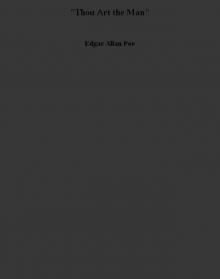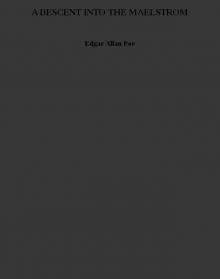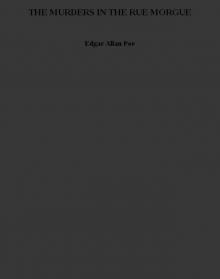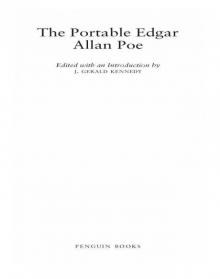- Home
- Edgar Allan Poe
Complete Tales & Poems Page 11
Complete Tales & Poems Read online
Page 11
the tree thr … h the,
when the word ‘through’ makes itself evident at once. But this discovery gives us three new letters, o, u, and g, represented by ‡, ?, and 3.
“Looking now, narrowly, through the cipher for combinations of known characters, we find, not very far from the beginning, this arrangement,
83(88, or egree,
which, plainly, is the conclusion of the word ‘degree,’ and gives us another letter, d, represented by †.
“Four letters beyond the word ‘degree,’ we perceive the combination
;46(;88.
“Translating the known characters, and representing the unknown by dots, as before, we read thus:
th.rtee,
an arrangement immediately suggestive of the word ‘thirteen,’ and again furnishing us with two new characters, i and n, represented by 6 and *.
“Referring, now, to the beginning of the cryptograph, we find the combination,
“Translating as before, we obtain
good,
which assures us that the first letter is A, and that the first two words are ‘A good.’
“It is now time that we arrange our key, as far as discovered, in a tabular form, to avoid confusion. It will stand thus:
“We have, therefore, no less than eleven of the most important letters represented, and it will be unnecessary to proceed with the details of the solution. I have said enough to convince you that ciphers of this nature are readily soluble, and to give you some insight into the rationale of their development. But be assured that the specimen before us appertains to the very simplest species of cryptograph. It now only remains to give you the full translation of the characters upon the parchment, as unriddled. Here it is:
“ ‘A good glass in the bishop’s hostel in the devil’s seat forty-one degrees and thirteen minutes northeast and by north main branch seventh limb east side shoot from the left eye of the death’s-head a bee-line from the tree through the shot fifty feet out.’ “
“But,” said I, “the enigma seems still in as bad a condition as ever. How is it possible to extort a meaning from all this jargon about ‘devil’s seats,’ ‘death’s-heads,’ and ‘bishop’s hostels’?”
“I confess,” replied Legrand, “that the matter still wears a serious aspect, when regarded with a casual glance. My first endeavor was to divide the sentence into the natural division intended by the cryptographist.”
“You mean, to punctuate it?”
“Something of that kind.”
“But how was it possible to effect this?”
“I reflected that it had been a point with the writer to run his words together without division, so as to increase the difficulty of solution. Now, a not over-acute man, in pursuing such an object, would be nearly certain to overdo the matter. When, in the course of his composition, he arrived at a break in his subject which would naturally require a pause, or a point, he would be exceedingly apt to run his characters, at this place, more than usually close together. If you will observe the MS., in the present instance, you will easily detect five such cases of unusual crowding. Acting upon this hint, I made the division thus:
“ ‘A good glass in the bishop’s hostel in the devil’s seat—forty-one degrees and thirteen minutes—northeast and by north—main branch seventh limb east side—shoot from the left eye of the death’s-head—a beeline from the tree through the shot fifty feet out.’ “
“Even this division,” said I, “leaves me still in the dark.”
“It left me also in the dark,” replied Legrand, “for a few days; during which I made diligent inquiry, in the neighborhood of Sullivan’s Island, for any building which went by the name of the ‘Bishop’s Hotel’; for, of course, I dropped the obsolete word ‘hostel.’ Gaining no information on the subject, I was on the point of extending my sphere of search, and proceeding in a more systematic manner, when, one morning, it entered into my head, quite suddenly, that this ‘Bishop’s Hostel’ might have some reference to an old family, of the name of Bessop, which, time out of mind, had held possession of an ancient manor-house, about four miles to the northward of the island. I accordingly went over to the plantation, and re-instituted my inquiries among the older negroes of the place. At length one of the most aged of the women said that she had heard of such a place as Bessop’s Castle, and thought that she could guide me to it, but that it was not a castle, nor a tavern, but a high rock.
“I offered to pay her well for her trouble, and, after some demur, she consented to accompany me to the spot. We found it without much difficulty, when, dismissing her, I proceeded to examine the place. The ‘castle’ consisted of an irregular assemblage of cliffs and rocks—one of the latter being quite remarkable for its height as well as for its insulated and artificial appearance. I clambered to its apex, and then felt much at a loss as to what should be next done.
“While I was busied in reflection, my eyes fell upon a narrow ledge in the eastern face of the rock, perhaps a yard below the summit upon which I stood. This ledge projected about eighteen inches, and was not more than a foot wide, while a niche in the cliff just above it gave it a rude resemblance to one of the hollow-backed chairs used by our ancestors. I made no doubt that here was the ‘devil’s-seat’ alluded to in the MS., and now I seemed to grasp the full secret of the riddle.
“The ‘good glass,’ I knew, could have reference to nothing but a telescope; for the world ‘glass’ is rarely employed in any other sense by seamen. Now here, I at once saw, was a telescope to be used, and a definite point of view, admitting no variation, from which to use it. Nor did I hesitate to believe that the phrases, ‘forty-one degrees and thirteen minutes,’ and ‘northeast and by north,’ were intended as directions for the levelling of the glass. Greatly excited by these discoveries, I hurried home, procured a telescope, and returned to the rock.
“I let myself down to the ledge, and found that it was impossible to retain a seat upon it except in one particular position. This fact confirmed my preconceived idea. I proceeded to use the glass. Of course, the ‘forty-one degrees and thirteen minutes’ could allude to nothing but elevation above the visible horizon, since the horizontal direction was clearly indicated by the words, ‘northeast and by north.’ This latter direction I at once established by means of a pocket-compass; then, pointing the glass as nearly at an angle of forty-one degrees of elevation as I could do it by guess, I moved it cautiously up or down, until my attention was arrested by a circular rift or opening in the foliage of a large tree that overtopped its fellows in the distance. In the centre of this rift I perceived a white spot, but could not, at first, distinguish what it was. Adjusting the focus of the telescope, I again looked, and now made it out to be a human skull.
“Upon this discovery I was so sanguine as to consider the enigma solved; for the phrase ‘main branch, seventh limb, east side,’ could refer only to the position of the skull upon the tree, while ‘shoot from the left eye of the death’s-head’ admitted, also, of but one interpretation, in regard to a search for buried treasure. I perceived that the design was to drop a bullet from the left eye of the skull, and that a bee-line, or, in other words, a straight line, drawn from the nearest point of the trunk through ‘the shot’ (or the spot where the bullet fell), and thence extended to a distance of fifty feet, would indicate a definite point—and beneath this point I thought it at least possible that a deposit of value lay concealed.”
“All this,” I said, “is exceedingly clear, and, although ingenious, still simple and explicit. When you left the ‘Bishop’s Hotel,’ what then?”
“Why, having carefully taken the bearings of the tree, I turned homeward. The instant that I left ‘the devil’s-seat,’ however, the circular rift vanished; nor could I get a glimpse of it afterward, turn as I would. What seems to me the chief ingenuity in this whole business, is the fact (for repeated experiment has convinced me it is a fact) that the circular opening in question is visible from no other attainable point of vie
w than that afforded by the narrow ledge upon the face of the rock.
“In this expedition to the ‘Bishop’s Hotel’ I had been attended by Jupiter, who had, no doubt, observed, for some weeks past, the abstraction of my demeanor, and took especial care not to leave me alone. But, on the next day, getting up very early, I contrived to give him the slip, and went into the hills in search of the tree. After much toil I found it. When I came home at night my valet proposed to give me a flogging. With the rest of the adventure I believe you are as well acquainted as myself.”
“I suppose,” said I, “you missed the spot, in the first attempt at digging, through Jupiter’s stupidity in letting the bug fall through the right instead of through the left eye of the skull.”
“Precisely. This mistake made a difference of about two inches and a half in the ‘shot’—that is to say, in the position of the peg nearest the tree; and had the treasure been beneath the ‘shot,’ the error would have been of little moment; but ‘the shot,’ together with the nearest point of the tree, were merely two points for the establishment of a line of direction ; of course the error, however trivial in the beginning, increased as we proceeded with the line, and by the time we had gone fifty feet threw us quite off the scent. But for my deep-seated impressions that treasure was here somewhere actually buried, we might have had all our labor in vain.”
“But your grandiloquence, and your conduct in swinging the beetle—how excessively odd! I was sure you were mad. And why did you insist upon letting fall the bug, instead of a bullet, from the skull?”
“Why, to be frank, I felt somewhat annoyed by your evident suspicions touching my sanity, and so resolved to punish you quietly, in my own way, by a little bit of sober mystification. For this reason I swung the beetle, and for this reason I let it fall from the tree. An observation of yours about its great weight suggested the latter idea.”
“Yes, I perceive; and now there is only one point which puzzles me. What are we to make of the skeletons found in the hole?”
“That is a question I am no more able to answer than yourself. There seems, however, only one plausible way of accounting for them—and yet it is dreadful to believe in such atrocity as my suggestion would imply. It is clear that Kidd—if Kidd indeed secreted this treasure, which I doubt not—it is clear that he must have had assistance in the labor. But this labor concluded, he may have thought it expedient to remove all participants in his secret. Perhaps a couple of blows with a mattock were sufficient, while his coadjutors were busy in the pit; perhaps it required a dozen—who shall tell?”
THE BALLOON-HOAX
[Astounding News by Express, viâ Norfolk!—The Atlantic Crossed in Three Days! Signal Triumph of Mr. Monck Mason’s Flying Machine!—Arrival at Sullivan’s Island, near Charleston, S. C., of Mr. Mason, Mr. Robert Holland, Mr. Henson, Mr. Harrison Ainsworth, and four others, in the Steering Balloon, “Victoria,” after a Passage of Seventy-five Hours from Land to Land! Full Particulars of the Voyage!
The subjoined jeu d’esprit with the preceding heading in magnificent capitals, well interspersed with notes of admiration, was originally published, as matter of fact, in the New-York Sun, a daily newspaper, and therein fully subserved the purpose of creating indigestible aliment for the quidnuncs during the few hours intervening between a couple of the Charleston mails. The rush for the “sole paper which had the news,” was something beyond even the prodigious; and, in fact, if (as some assert) the “Victoria” did not absolutely accomplish the voyage recorded, it will be difficult to assign a reason why she should not have accomplished it.]
THE great problem is at length solved! The air, as well as the earth and the ocean, has been subdued by science, and will become a common and convenient highway for mankind. The Atlantic has been actually crossed in a Balloon! and this too without difficulty—without any great apparent danger—with thorough control of the machine—and in the inconceivably brief period of seventy-five hours from shore to shore! By the energy of an agent at Charleston, S. C., we are enabled to be the first to furnish the public with a detailed account of this most extraordinary voyage, which was performed between Saturday, the 6th instant, at 11 A.M. and 2 P.M., on Tuesday, the 9th instant, by Sir Everard Bringhurst; Mr. Osborne, a nephew of Lord Bentinck’s; Mr. Monck Mason and Mr. Robert Holland, the well-known aëronauts; Mr. Harrison Ainsworth, author of “Jack Sheppard,” etc.; and Mr. Henson, the projector of the late unsuccessful flying machine—with two seamen from Woolwich—in all, eight persons. The particulars furnished below may be relied on as authentic and accurate in every respect, as, with a slight exception, they are copied verbatim from the joint diaries of Mr. Monck Mason and Mr. Harrison Ainsworth, to whose politeness our agent is also indebted for much verbal information respecting the balloon itself, its construction, and other matters of interest. The only alteration in the MS. received, has been made for the purpose of throwing the hurried account of our Agent, Mr. Forsyth, into a connected and intelligible form.
“THE BALLOON
“Two very decided failures, of late,—those of Mr. Henson and Sir George Cayley,—had much weakened the public interest in the subject of aërial navigation. Mr. Henson’s scheme (which at first was considered very feasible even by men of science) was founded upon the principle of an inclined plane, started from an eminence by an extrinsic force, applied and continued by the revolution of impinging vanes, in form and number resembling the vanes of a windmill. But, in all the experiments made with models at the Adelaide Gallery, it was found that the operation of these fans not only did not propel the machine, but actually impeded its flight. The only propelling force it ever exhibited, was the mere impetus acquired from the descent of the inclined plane; and this impetus carried the machine farther when the vanes were at rest, than when they were in motion—a fact which sufficiently demonstrates their inutility; and in the absence of the propelling, which was also the sustaining, power, the whole fabric would necessarily descend. This consideration led Sir George Cayley to think only of adapting a propeller to some machine having of itself an independent power of support—in a word, to a balloon; the idea, however, being novel, or original, with Sir George, only so far as regards the mode of its application to practice. He exhibited a model of his invention at the Polytechnic Institution. The propelling principle, or power, was here, also, applied to interrupted surfaces, or vanes, put in revolution. These vanes were four in number, but were found entirely ineffectual in moving the balloon, or in aiding its ascending power. The whole project was thus a complete failure.
“It was at this juncture that Mr. Monck Mason (whose voyage from Dover to Weilburg in the balloon, ‘Nassau,’ occasioned so much excitement in 1837) conceived the idea of employing the principle of the Archimedean screw for the purpose of propulsion through the air—rightly attributing the failure of Mr. Henson’s scheme, and of Sir George Cayley’s, to the interruption of surface in the independent vanes. He made the first public experiment at Willis’s Rooms, but afterward removed his model to the Adelaide Gallery.
“Like Sir George Cayley’s balloon, his own was an ellipsoid. Its length was thirteen feet six inches—height, six feet eight inches. It contained about three hundred and twenty cubic feet of gas, which, if pure hydrogen, would support twenty-one pounds upon its first inflation, before the gas has time to deteriorate or escape. The weight of the whole machine and apparatus was seventeen pounds—leaving about four pounds to spare. Beneath the centre of the balloon, was a frame of light wood, about nine feet long, and rigged on to the balloon itself with a network in the customary manner. From this framework was suspended a wicker basket or car.
“The screw consists of an axis of hollow brass tube, eighteen inches in length, through which, upon a semi-spiral inclined at fifteen degrees, pass a series of steel-wire radii, two feet long, and thus projecting a foot on either side. These radii are connected at the outer extremities by two bands of flattened wire—the whole in this manner forming the framework of the screw, which is
completed by a covering of oiled silk cut into gores, and tightened so as to present a tolerably uniform surface. At each end of its axis this screw is supported by pillars of hollow brass tube descending from the hoop. In the lower ends of these tubes are holes in which the pivots of the axis revolve. From the end of the axis which is next the car, proceeds a shaft of steel, connecting the screw with the pinion of a piece of spring machinery fixed in the car. By the operation of this spring, the screw is made to revolve with great rapidity, communicating a progressive motion to the whole. By means of the rudder, the machine was readily turned in any direction. The spring was of great power, compared with its dimensions, being capable of raising forty-five pounds upon a barrel of four inches diameter, after the first turn, and gradually increasing as it was wound up. It weighed, altogether, eight pounds six ounces. The rudder was a light frame of cane covered with silk, shaped somewhat like a battledore, and was about three feet long, and at the widest, one foot. Its weight was about two ounces. It could be turned flat, and directed upward or downward, as well as to the right or left; and thus enabled the aëronaut to transfer the resistance of the air which in an inclined position it must generate in its passage, to any side upon which he might desire to act; thus determining the balloon in the opposite direction.
“This model (which, through want of time, we have necessarily described in an imperfect manner) was put in action at the Adelaide Gallery, where it accomplished a velocity of five miles per hour; although, strange to say, it excited very little interest in comparison with the previous complex machine of Mr. Henson—so resolute is the world to despise any thing which carries with it an air of simplicity. To accomplish the great desideratum of aërial navigation, it was very generally supposed that some exceedingly complicated application must be made of some unusually profound principle in dynamics.

 The Works of Edgar Allan Poe — Volume 2
The Works of Edgar Allan Poe — Volume 2 The Works of Edgar Allan Poe — Volume 1
The Works of Edgar Allan Poe — Volume 1 The Works of Edgar Allan Poe — Volume 3
The Works of Edgar Allan Poe — Volume 3 The Works of Edgar Allan Poe — Volume 5
The Works of Edgar Allan Poe — Volume 5 The Works of Edgar Allan Poe — Volume 4
The Works of Edgar Allan Poe — Volume 4 The Tell-Tale Heart
The Tell-Tale Heart The Raven (Penguin)
The Raven (Penguin) The Paris Mysteries
The Paris Mysteries Tales of Terror from Edgar Allan Poe
Tales of Terror from Edgar Allan Poe The Fall of the House of Usher
The Fall of the House of Usher The Golden Book of World's Greatest Mysteries
The Golden Book of World's Greatest Mysteries The Narrative of Arthur Gordon Pym of Nantucket
The Narrative of Arthur Gordon Pym of Nantucket Ligeia
Ligeia The Landscape Garden
The Landscape Garden Complete Tales & Poems
Complete Tales & Poems Great Tales and Poems of Edgar Allan Poe
Great Tales and Poems of Edgar Allan Poe The Colloquy of Monos and Una
The Colloquy of Monos and Una The Oblong Box
The Oblong Box Thou Art the Man
Thou Art the Man A DESCENT INTO THE MAELSTROM
A DESCENT INTO THE MAELSTROM THE MURDERS IN THE RUE MORGUE
THE MURDERS IN THE RUE MORGUE The Business Man
The Business Man The Mystery of Marie Rogêt
The Mystery of Marie Rogêt Metzengerstein
Metzengerstein The Man That Was Used Up
The Man That Was Used Up William Wilson
William Wilson The Philosophy of Composition
The Philosophy of Composition The Portable Edgar Allan Poe
The Portable Edgar Allan Poe Bon-Bon
Bon-Bon A Predicament
A Predicament The Premature Burial
The Premature Burial The Angel of the Odd
The Angel of the Odd The Man of the Crowd
The Man of the Crowd Never Bet the Devil Your Head
Never Bet the Devil Your Head The Tell-Tale Heart and Other Writings
The Tell-Tale Heart and Other Writings The System of Doctor Tarr and Professor Fether
The System of Doctor Tarr and Professor Fether Selected Tales (Oxford World's Classics)
Selected Tales (Oxford World's Classics) Essential Tales and Poems of Edgar Allan Poe (Barnes & Noble Classics Series)
Essential Tales and Poems of Edgar Allan Poe (Barnes & Noble Classics Series) MS. Found in a Bottle
MS. Found in a Bottle Some Words with a Mummy
Some Words with a Mummy The Science Fiction of Edgar Allan Poe (Penguin Classics)
The Science Fiction of Edgar Allan Poe (Penguin Classics) King Pest
King Pest CRITICISM
CRITICISM How to Write a Blackwood Article
How to Write a Blackwood Article Mystification
Mystification Diddling Considered as One of the Exact Sciences
Diddling Considered as One of the Exact Sciences Steampunk Poe
Steampunk Poe The Literary Life of Thingum Bob, Esq.
The Literary Life of Thingum Bob, Esq. Classic Crime Collection
Classic Crime Collection Complete Stories and Poems of Edgar Allen Poe
Complete Stories and Poems of Edgar Allen Poe Berenice
Berenice The Black Cat
The Black Cat The Slender Poe Anthology
The Slender Poe Anthology The Science Fiction of Edgar Allan Poe
The Science Fiction of Edgar Allan Poe The Assignation
The Assignation The Thousand-and-Second Tale of Scheherazade
The Thousand-and-Second Tale of Scheherazade The Raven and Other Short Stories
The Raven and Other Short Stories The Spectacles
The Spectacles Hop-Frog
Hop-Frog The Purloined Letter
The Purloined Letter Mellonta Tauta
Mellonta Tauta The Balloon-Hoax
The Balloon-Hoax Landor's Cottage
Landor's Cottage Mesmeric Revelation
Mesmeric Revelation The Pit and the Pendulum
The Pit and the Pendulum